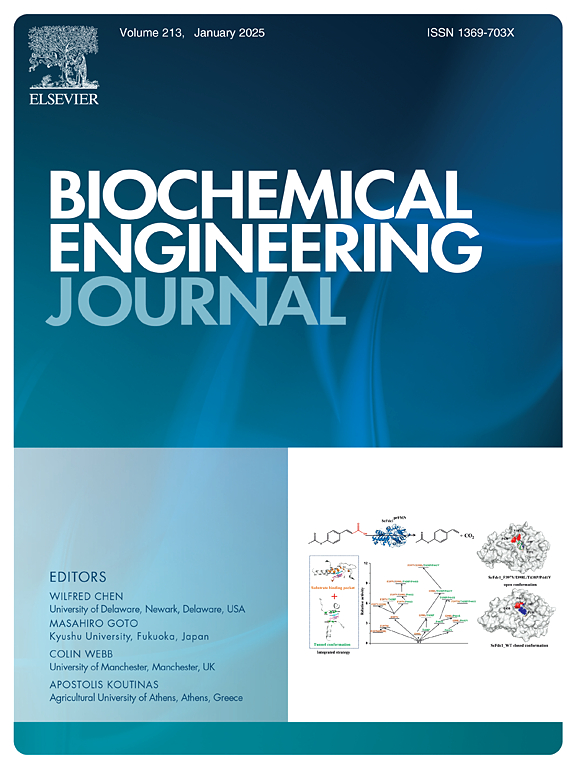IF 3.7
3区 生物学
Q2 BIOTECHNOLOGY & APPLIED MICROBIOLOGY
引用次数: 0
摘要
本研究将碳点(CD)和三氧化钨(WO3)结合起来,制备了 CDs-WO3 复合材料,用于光催化处理废水中的细菌和有机染料。同时还研究了其光学特性、抗菌特性、抗菌机理和光催化降解性能。CDs-WO3 复合材料的紫外吸收强度增强,可见光吸收范围扩大,电荷转移和载流子分离能力良好,带隙减小。CDs-WO3 对金黄色葡萄球菌的抗菌率可达 98%。研究发现 CDs-WO3 的抗菌机制是活性氧损伤机制。电子顺磁共振(EPR)分析表明,CDs-WO3 的活性氧信号强度明显高于 WO3,表明产生了更多的 -O2- 和 -OH。细菌细胞活性分析表明,CDs-WO3 复合材料降低了细菌呼吸链脱氢酶的活性,导致细胞膜脂质过氧化反应加剧。光催化降解性能表明,CDs-WO3 对亚甲基蓝和孔雀石绿的光催化降解效率分别达到 87 % 和 88.04 %。CDs-WO3 在实际水体中的应用也显示出良好的抗菌效果和染料降解效果。本文章由计算机程序翻译,如有差异,请以英文原文为准。
Preparation and study of CDs-WO3 composites with enhanced photocatalytic antimicrobial properties and degradation of dyes
In this study, carbon dots (CDs) and tungsten trioxide (WO3) were combined to prepare CDs-WO3 composites for photocatalytic treatment of bacteria and organic dyes in wastewater. The optical properties, antimicrobial properties, antimicrobial mechanism, and photocatalytic degradation performance were also investigated. The CDs-WO3 composites exhibited enhanced UV absorption intensity, broadened visible light absorption range, good charge transfer and carrier separation abilities, and reduced bandgap. The antimicrobial rate of CDs-WO3 against Staphylococcus aureus can reach 98 %. The antibacterial mechanism of CDs-WO3 was found to be the reactive oxygen species damage mechanism. Electron paramagnetic resonance (EPR) analysis revealed that the reactive oxygen species signal intensity of CDs-WO3 was significantly higher than that of WO3, indicating that more ·O2- and ·OH were produced. The analysis of bacterial cell activity demonstrated that CDs-WO3 composites reduced the activity of respiratory chain dehydrogenase in bacteria, which resulted in increased lipid peroxidation in the cell membrane. The photocatalytic degradation performance showed that the photocatalytic degradation efficiency of CDs-WO3 for methylene blue and malachite green reached 87 % and 88.04 %, respectively. The application of CDs-WO3 in real water bodies also showed good antibacterial effect and dye degradation.
求助全文
通过发布文献求助,成功后即可免费获取论文全文。
去求助
来源期刊

Biochemical Engineering Journal
工程技术-工程:化工
CiteScore
7.10
自引率
5.10%
发文量
380
审稿时长
34 days
期刊介绍:
The Biochemical Engineering Journal aims to promote progress in the crucial chemical engineering aspects of the development of biological processes associated with everything from raw materials preparation to product recovery relevant to industries as diverse as medical/healthcare, industrial biotechnology, and environmental biotechnology.
The Journal welcomes full length original research papers, short communications, and review papers* in the following research fields:
Biocatalysis (enzyme or microbial) and biotransformations, including immobilized biocatalyst preparation and kinetics
Biosensors and Biodevices including biofabrication and novel fuel cell development
Bioseparations including scale-up and protein refolding/renaturation
Environmental Bioengineering including bioconversion, bioremediation, and microbial fuel cells
Bioreactor Systems including characterization, optimization and scale-up
Bioresources and Biorefinery Engineering including biomass conversion, biofuels, bioenergy, and optimization
Industrial Biotechnology including specialty chemicals, platform chemicals and neutraceuticals
Biomaterials and Tissue Engineering including bioartificial organs, cell encapsulation, and controlled release
Cell Culture Engineering (plant, animal or insect cells) including viral vectors, monoclonal antibodies, recombinant proteins, vaccines, and secondary metabolites
Cell Therapies and Stem Cells including pluripotent, mesenchymal and hematopoietic stem cells; immunotherapies; tissue-specific differentiation; and cryopreservation
Metabolic Engineering, Systems and Synthetic Biology including OMICS, bioinformatics, in silico biology, and metabolic flux analysis
Protein Engineering including enzyme engineering and directed evolution.
 求助内容:
求助内容: 应助结果提醒方式:
应助结果提醒方式:


